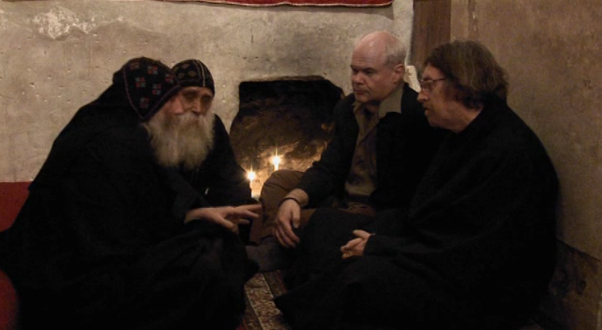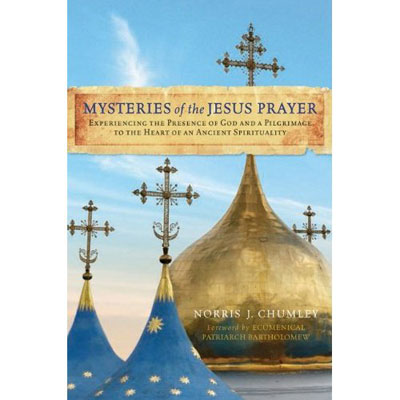Mysteries of the Jesus Prayer (Frederica Mathewes-Green)
10 Φεβρουαρίου 2017
A Book Review by Frederica Mathewes-Green
Mysteries of the Jesus Prayer: Experiencing the Presence of God and a Pilgrimage to the Heart of an Ancient Spirituality
by Norris J. Chumley, HarperOne, 2011, 224 PP
What’s so mysterious about the Jesus Prayer? It’s one of the shortest and simplest prayers you can find: “Lord Jesus Christ, Son of God, have mercy on me.” It’s one of the most ancient prayers, too; think of how often in the Gospels people ask Jesus for mercy. A prayer for mercy would likely have been one of the variations when the Desert Mothers and Fathers (AD 2nd-5th c), who sought to pray constantly, were trying out different short, repeated verses of Scripture to discipline the wandering mind. (St. Augustine reports that they “have very frequent prayers, but these are very brief.”) Those ancient monasteries and hermitages are the spiritual nursery in which the Jesus Prayer had its birth.

It might be better to call it a spiritual laboratory, though, because this short petition has profound effects. To some extent, that’s only natural: whether it is a Christian prayer, a Hindu mantra, or a two-item shopping list, any attempt to keep repeating a phrase—any attempt at all to restrain the mind’s aimless ramble—is going to reverberate through mind, memory, and will. But since this is, in fact, a prayer, invoking Jesus Christ and asking for his mercy, it has deep and life-changing effects on the person makes it a mental habit. In time, the teaching is, you begin to sense a direct connection with the presence of God, and to hear his responding voice.
Over the centuries a lot of wisdom has built up about how to use the Jesus Prayer safely and effectively. It’s wisdom that has been conserved mostly in Orthodox monasteries, which is where men and women go who want make this single-minded pursuit of union with God. When it comes to prayer, a monastery is where you find the rocket scientists.
Author Norris Chumley explains that, while pursuing a degree at Union Theological Seminary in New York, he wanted to learn more about how to know Christ through prayer—not just book-knowledge, but by direct experience. He found in his church history professor, the Very Rev. Dr. John A. McGuckin (an Orthodox priest), a fellow pilgrim, and began the eight-year process of producing a documentary and a book, both bearing this title. It is a unique project, for monastics traditionally keep their spiritual lives very private. By presenting frankly his desire to introduce the West to the power of the Jesus Prayer, Chumley found doors opening in Orthodox monasteries in Egypt, Greece, Romania, Ukraine, and Russia. He was able to interview monks and nuns and record their first-hand reports of the effects of this profound and simple prayer.

What I found most winning, even surprising, about the book is Chumley’s unaffected manner. It is easy for those who write about spiritual profundities to grow long-faced. Self-importance is a constant temptation. One who pretends to be an expert on mysticism would be in particular danger. But throughout Chumley maintains a sunny, simple quality. Everywhere he goes he is receptive and grateful. This tone begins on the dedication page, which reads, “This book is dedicated to Jesus Christ, and the likeness of him in all of us.” I can’t think of another time I’ve seen a book dedicated to Jesus. The Acknowledgements begin: “Above all, I thank God for my life, my family, my interests, and my work. I thank God for Jesus Christ, God in a human life… I thank God for the reality of the Cross, for Jesus’ resurrection, for the Holy Spirit.” When explaining the words of the Jesus Prayer, he doesn’t flinch: “Son of God is meant literally. Jesus is the Second Person of the Holy Trinity, begotten by God the Father. For the salvation of the world he came down from heaven and was born of the Blessed Virgin Mary. He is the Son of God and the son of Mary, fully God and fully human.”
The Dean Emeritus of St. Vladimir’s Orthodox Theological Seminary, the Very Rev. Dr. Thomas Hopko, says, “Everybody wants the Jesus Prayer, but nobody wants Jesus.” Some people who explore Orthodox prayer disciplines are looking for spiritual experiences, not a Lord. That is refreshingly not the case with Mysteries of the Jesus Prayer.
The first stop in Chumley’s pilgrimage is the most ancient site of Orthodox monasticism, the monastery of St. Antony (AD 251-356) in the Red Sea mountains a couple of hundred miles southeast of Cairo. Though he had gone to some trouble to arrange the necessary permissions, Chumley found that no one in the monastery had been informed. Yet here, as elsewhere, he found a ready welcome.
From the monastery Chumley climbs the 1100 steps up the mountainside to St. Antony’s cave, and finds it “one of the holiest places I’ve ever been.” In the monastery chapel a “smallish monk” takes him aside and says, “God told me you were coming,” and reveals himself to be the monastery’s starets (spiritual elder, a separate role from that of abbot). He is Fr. Lazarus, previously an atheist and professor of Marxist philosophy and economics in New Zealand. “One day he felt a powerful and unexpected call to convert to Christianity and to travel to Egypt and seek God at St. Antony’s Monastery. He has been there ever since.”
Chumley next journeys to the Monastery of St. Catherine on Mt. Sinai, passing one armed checkpoint after another. On arrival, however, he found that, though he had gone to some trouble to arrange the necessary permissions, no one in the monastery had been informed. The abbot welcomed him, however, and gave him and his crew permission to film “anywhere and everywhere.”
This monastery is of particular historic interest because, being geographically remote, it has mostly escaped invasion and destruction. Much of it remains today as it was when first built, around AD 550. In the ancient, jewel-like monastery church Chumley and his crew attend the four-hour daily liturgy that begins in the wee hours and concludes at dawn, filming even behind the iconostasis, beside the altar. This service provides a daily dose of silence and awe that strengthens the monks for the daily assault of tourists. Though monastics voluntarily take on many serious disciplines, that of offering hospitality to busloads of photo-snapping visitors must be among the most daunting.
Chumley also gets to tour the monastery’s ossuary. In lands where there is limited room for burial, a common custom is to disinter a body after a few years and free up the grave for a new tenant. The gathered bones, taking up much less space, are then laid to rest for the second time. St. Catherine’s ossuary is a small building full of bones: a pile of skulls over here, femurs over there, and a separate pile for abbots. Here Chumley has one of several brushes with the miraculous. He notices an unusual scent in the room, “a unique fragrance, like musk oil mixed with citrus and herb.” Fr. Neilos explains that the bones of holy people sometimes exude a fragrant oil. This phenomenon may start and stop repeatedly, over the centuries. “I have never smelled anything like it before. No cologne or perfume comes close.” (He encounters it again in the Monastery of the Caves in Kiev. Fifty feet underground, in a network of tunnels, lie the cells and burial places of countless saints, and Chumley again finds the mysterious fragrance beyond words.)
The next stop is Mt. Athos, a rocky peninsula in northern Greece which is home to some 20 Orthodox monasteries and untold numbers of hermits. Though Chumley had gone to some trouble to arrange the necessary permissions, when he opened his bag to show the abbot and monks of Vatopedi Monastery his camera and sound equipment, there was a flutter “as if I were about to draw out something unholy, or at least unwholesome.” Abbot Ephraim gestured for the others to settle down, then patted Chumley’s chest, over his heart. “I could feel a powerful energy coursing from my head to my toes. It felt as if he’d psychically read my soul.” (The ability to be a “soul-reader,” to see a person’s history and struggles at a glance, is a common attribute of holy monastics.) The abbot said, “Fine. You are sincere,” and the cameras were welcomed everywhere.
And so it goes, with further visits to Romania, Kiev, and Russia. In every place Chumley meets monks and nuns who are open and friendly, and to all appearances normal, despite having dedicated their lives to unceasing prayer. In Orthodox monasticism, there isn’t an expectation that monastics will perform a calling in the world (such as medicine or teaching); there aren’t even orders (such as Franciscan, Benedictine, or Carthusian). Instead it’s all about prayer, and an expectation that prayer changes the world. In Romania, Archbishop Justinian explains, “We have three virtues: fasting, almsgiving, and prayer…But out of those, prayer is the key. It is a means of gaining direct contact with God.” Prayer is the source even of theology. In his Foreword, the Ecumenical Patriarch, Archbishop Bartholomew, states that profound prayer is “the living seed of all spiritual life and theological thought.”
It’s an interesting to consider what role persecution and martyrdom might have played in the forging of this spirituality. Chumley mentions that, even today, Christians in Egypt are at risk for mob violence: “Riots broke out a few years back…when a rumor spread that Christians were sprinkling a magic liquid on Muslim women’s burkas that caused little crosses to materialize on the fabric.” On his journey to Mt. Sinai he has an armed bodyguard, and violence there is nothing new: the sixth-century emperor built St. Catherine’s because Bedouins were killing the monks on a regular basis. In most middle-eastern lands, of course, Christians were conquered by Muslims earlier or later during the course of 800 years. In the formerly-Soviet lands, the toll was very great. At the turn of the twentieth century there were 1200 monks living at the Monastery of the Caves in Kiev; the communists shot or imprisoned them all. In Romania, communists inflicted a similar toll, and Ceaucescu bulldozed dozens of historic churches.
After the fall revival came swiftly, if not always surely. In Romania, in particular, there has been a surge in monastic vocations; Chumley notes a “vibrancy and energy that is contagious. We felt it…everywhere we traveled in Romania.” (Mt. Athos, too, is experiencing a revival. “In the 1960s it seemed that Athos was dying,” with only 1,100 monks, most in their fifties. Now there are 2,200 monks, most in their twenties and thirties.)
But Sister Josephina, abbess of the immense Varatec Monastery in Romania (home to 600 nuns), says that many who come to try a vocation end up leaving again. Father Jonas, abbot of the St. Jonas Monastery near Kiev, says that there may have been fewer monks during the communist era, “but they were real monks; they were martyrs. They suffered a lot. And now there are more monks, but their quality is not the same.” (This may be reflexive humility. Chumley notes, “If Fr. Jonas was suggesting that today’s monks lacked the fervor and commitment of their predecessors, I did not see it.”)
Mysteries of the Jesus Prayer overflows with the monastics’ advice and stories about prayer, and these are expressed in simple rather than esoteric terms. The ex-atheist Fr. Lazarus, of St. Antony’s, says that the silence of being in a beautiful, quiet place is “transient; it will not last.” Interior silence, on the other hand, is “much harder to find, but it is long-lasting. …I am living up there in the mountain. For long periods of time—two weeks, three weeks, one month—I don’t see any people.” Yet, even though he is not committing “sins of action,” he must fight to fend off memories and other thoughts. “If I don’t have interior silence, I can be as busy in mind as if I were in New York.”
Sometimes words just aren’t enough. In “rapid-fire Romanian,” Archbishop Justinian describes how to cultivate the Jesus Prayer, saying it without ceasing whenever one gets a chance, “until it becomes a habit.” With time, “the thought itself becomes a prayer,” and earthly worries no longer dominate the mind. Then the cycle of habitual thoughts begins to undergo a change. “Now you start having the pure thoughts, and pure thoughts exercise a tendency toward the heart and it starts changing the heart. This is the mystery. This is the sacrament.”

Chumley says that, as the Archbishop was talking, he couldn’t understand word (till it was translated later), but tried to intuit what these words meant. Perhaps the Archbishop sensed this, because he abruptly took a different tack. Like the abbot on Mt. Athos, “Suddenly he reached out and took my hand with his, and he put his other hand on my chest. Immediately I felt a truly strong presence of God coursing through me. Deeply moved, I began to cry.”
As you can see, Mysteries of the Jesus Prayer is not a volume of devotional foggery, but a first-hand account of a rare pilgrimage. Chumley is able to interview many wise monastics, in itself an unusual achievement, and he passes on to us their valuable sayings. But he also encounters moments that are surprising, that involve the body as much as the soul, and challenge a view that would restrict spirituality to the ethereal realm. If prayer is going to change the world, it will have to intersect with material reality. If a monastic is going to gain the heights of effective prayer, he or she will have to train like an athlete. Praying is hard work. And as Fr. Jonas says, “Without prayer a monk is just a man in a black dress.”
This book review was published in Books and Culture; March-April, 2011 and at http://www.frederica.com and is posted here with permission.





